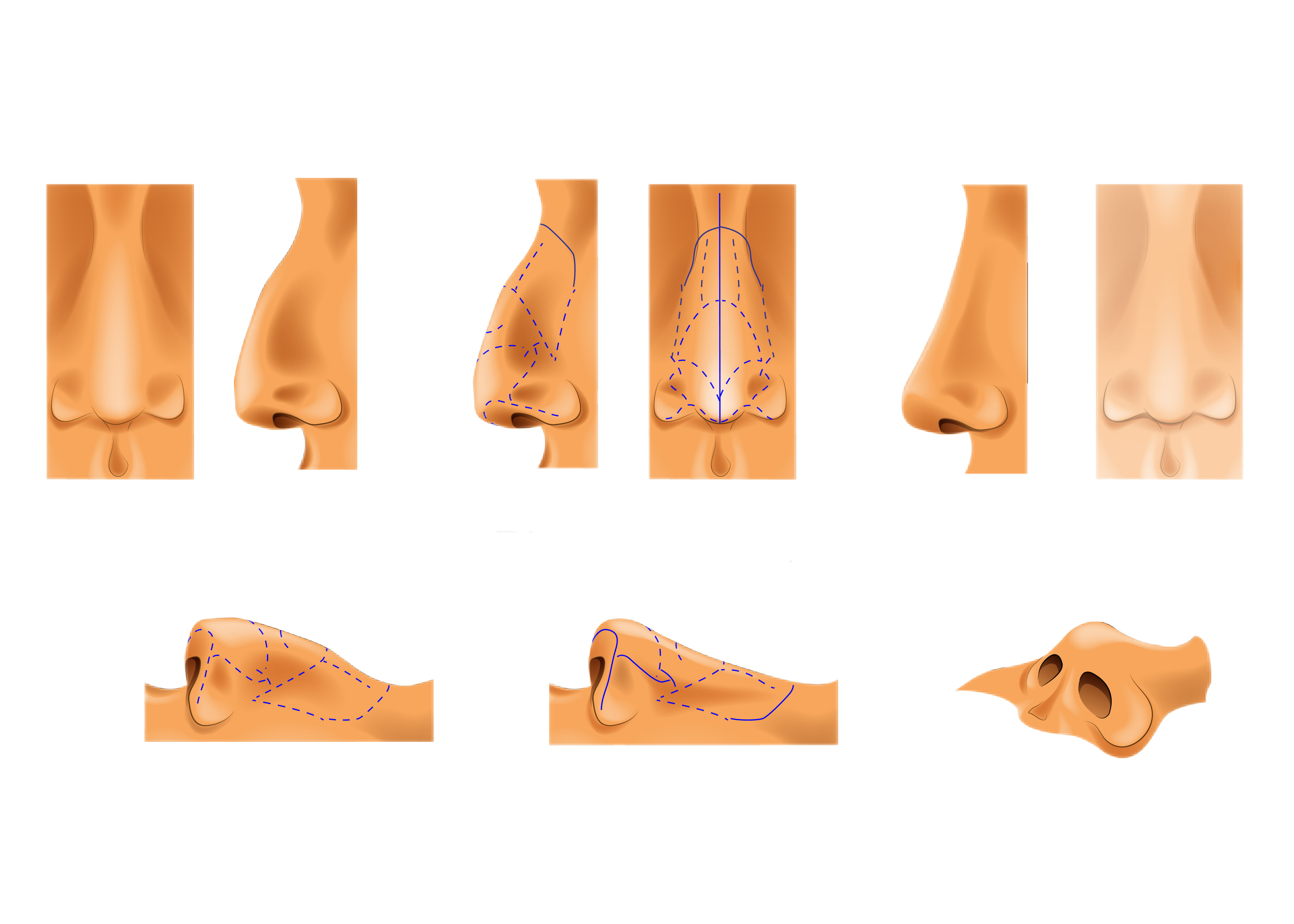Septorhinoplasty is a surgical procedure that combines the correction of nasal septum deviations with the enhancement of the appearance of the nose.
Septorhinoplasty can be performed for both cosmetic and medical reasons. In some cases, the septum deviation may obstruct the airways and cause breathing difficulties, while in other cases, patients may seek to improve the appearance of their nose.
This article provides an overview of septorhinoplasty, including the definition, differences between septorhinoplasty and rhinoplasty, alternatives to the procedure, requirements for treatment candidates, step-by-step explanation of the surgical procedure, preparing for the surgery, risks and complications, recovery after the surgery, and a conclusion.
If you are considering septorhinoplasty, it is important to understand the procedure thoroughly, including its benefits and risks. In Turkey, you can find highly qualified and experienced plastic surgeons who can guide you through the entire process and help you achieve your desired results.
Septorhinoplasty is a surgical procedure that combines both rhinoplasty (nose job) and septoplasty (deviated septum correction) in one operation. The goal of this procedure is to correct both the external appearance and internal structure of the nose.
While rhinoplasty focuses on reshaping the external appearance of the nose, septoplasty corrects the internal nasal structure, such as the septum that separates the two nasal cavities. Septorhinoplasty is often recommended for patients who suffer from both cosmetic and functional nasal problems.
It is important to note that septorhinoplasty is different from rhinoplasty alone. Rhinoplasty is a cosmetic procedure that only addresses the external appearance of the nose, whereas septorhinoplasty involves both external and internal corrections.
There are some alternative treatments to septorhinoplasty, depending on the individual's specific needs. For example, non-surgical rhinoplasty using injectable fillers is an option for those seeking to change the shape of their nose without undergoing surgery. However, it should be noted that non-surgical rhinoplasty is a temporary solution and not suitable for all cases.

Septorhinoplasty is a surgical procedure that addresses both functional and aesthetic concerns of the nose. There are various reasons why people may consider this procedure, such as breathing difficulties due to a deviated septum or improving the appearance of the nose.
Not everyone is a candidate for septorhinoplasty. In general, suitable candidates for this procedure should:
Before undergoing septorhinoplasty, candidates should schedule a consultation with a qualified plastic surgeon to determine if they are suitable for the procedure. During the consultation, the surgeon will evaluate the candidate's health history, examine their nose, and discuss their goals and expectations for the surgery.
It is important to note that septorhinoplasty is not recommended for individuals who are pregnant, have uncontrolled high blood pressure, or have certain medical conditions that increase the risk of complications during surgery.

Preparing for septorhinoplasty is an important step in ensuring a successful surgery and recovery. During the consultation process, your surgeon will evaluate your health history and the shape of your nose to determine if septorhinoplasty is the right choice for you. You should disclose any medications you are taking, including vitamins and supplements, as well as any underlying medical conditions.
Your surgeon may also provide instructions for preparing for the surgery. This may include stopping certain medications, quitting smoking, and avoiding alcohol and certain foods in the days leading up to the procedure. It's important to follow these instructions carefully to reduce the risk of complications during and after the surgery.
If you are traveling to Turkey for your surgery, it's important to plan ahead and make sure you have all the necessary documents and arrangements in place. You may also want to consider arranging accommodations and transportation for after the surgery, as you may need to rest for several days before returning home.
Table: Preparing for septorhinoplasty in Turkey
| Instructions | Details |
| Disclose medications | Provide a list of all medications, vitamins, and supplements you are taking to your surgeon |
| Lifestyle changes | Follow instructions to quit smoking and avoid alcohol and certain foods leading up to the surgery |
| Travel arrangements | Plan ahead for transportation and accommodations in Turkey |
| Post-surgery recovery | Arrange for a period of rest after the surgery before returning home |
Septorhinoplasty is a complex surgical procedure that aims to improve both the function and appearance of the nose. It is usually performed under general anesthesia and can take several hours depending on the extent of the surgery.

Here are the main steps of the septorhinoplasty procedure:
It is important to note that every patient is different, and the specific steps of the septorhinoplasty procedure may vary depending on the individual's needs and goals.
In Turkey, septorhinoplasty is a popular procedure that is performed by highly skilled and experienced plastic surgeons. The country is known for its advanced medical facilities, state-of-the-art technology, and affordable prices. Many people from around the world travel to Turkey for plastic surgery procedures, including septorhinoplasty, due to the high quality of care and competitive prices offered by the country's clinics and hospitals.
Septorhinoplasty is a surgical procedure that combines septoplasty (correction of a deviated septum) and rhinoplasty (cosmetic alteration of the nose) to improve both function and aesthetics of the nose. The cost of septorhinoplasty can vary significantly depending on several factors:
Surgeon's Experience and Reputation: Highly experienced and well-known surgeons often charge more for their expertise.
Location: The cost can vary by region and even within the same city or country. Urban areas with a higher cost of living generally have higher surgical fees.
Facility Fees: Surgical procedures are typically performed in a hospital or an accredited surgical facility, and these facilities charge fees for their services.
Anesthesia: The type of anesthesia used (local or general) can affect the cost. General anesthesia is usually more expensive.
Complexity of the Procedure: The extent of the surgical correction required, whether it's a minor adjustment or a more complex reconstruction, can influence the cost.
Preoperative Tests and Consultations: Costs associated with preoperative tests, consultations, and post-operative follow-ups may be included in the overall price.
Medical Insurance: In some cases, septorhinoplasty may be partially covered by medical insurance if it's performed primarily for medical reasons, such as correcting breathing difficulties.
Additional Costs: Additional expenses may include prescription medications, post-operative care, and potential revision surgeries.
Open septorhinoplasty is a surgical procedure performed by an ear, nose, and throat (ENT) or plastic surgeon to address both functional and aesthetic concerns of the nose. In this surgical approach, a small incision is made on the columella, the strip of skin and cartilage that separates the nostrils. This incision allows the surgeon to lift the nasal skin and gain direct access to the underlying nasal structures, including the septum (the partition between the two nostrils), cartilage, and bone.
Open septorhinoplasty is commonly used to correct a deviated septum, improve breathing difficulties, or repair structural issues within the nose. It is also employed for cosmetic purposes, such as reshaping and resizing the nose to enhance its appearance. By providing a clear view and precise control over the nasal structures, the open approach allows for more intricate and customized surgical adjustments, making it a versatile technique for both functional and aesthetic nose surgery.
Septorhinoplasty, commonly known as a nose job, is a surgical procedure that aims to improve both the function and appearance of the nose. The recovery process after septorhinoplasty is a crucial phase that patients should be prepared for. Here's a short description of what to expect during septorhinoplasty recovery:
Septorhinoplasty recovery typically spans several weeks, and it involves different stages of healing:
Immediate Post-Op: Right after the surgery, patients may experience swelling, bruising, and discomfort around the nose and sometimes even the eyes. Nasal packing or splints may be placed to support the newly shaped nose and septum. Breathing through the nose can be challenging during this period.
First Week: During the first week, it's essential to rest and keep the head elevated to reduce swelling. Pain medication prescribed by the surgeon can help manage discomfort. Patients should avoid strenuous activities, and it's common to have congestion and difficulty breathing through the nose due to swelling.
2-3 Weeks: Swelling and bruising should gradually subside, and patients may start to see initial results. The nasal splints or packing are usually removed within this time frame. Breathing may improve as the nasal passages begin to clear.
4-6 Weeks: Most patients can resume light activities and return to work or school. However, it's essential to avoid any contact sports or activities that might risk injury to the nose. Full recovery may take several months, during which the nose's final shape becomes more apparent.
Long-Term: Complete healing and the final result of the septorhinoplasty can take up to a year or more. It's vital to follow the surgeon's post-operative instructions carefully, including any follow-up appointments. Some patients may require additional minor revisions for optimal results.
Septorhinoplasty Splint Removal is the final step in the surgical process of septorhinoplasty, a medical procedure designed to enhance both the function and appearance of the nose. Typically performed about one week after the surgery, this procedure involves the careful removal of the splint or cast that has been protecting and supporting the newly reconstructed nose.
The removal of the septorhinoplasty splint is a relatively quick and straightforward process carried out by a medical professional. It marks a significant milestone in the patient's recovery journey, as it allows them to finally see and appreciate the results of their surgery. After splint removal, patients can expect some mild discomfort and swelling, which will gradually subside over the following weeks, revealing the improved nasal function and appearance achieved through septorhinoplasty.
| Risk or complication | Description |
| Bleeding | Some bleeding is normal after surgery, but excessive bleeding can be dangerous and may require additional treatment. |
| Infection | Infection is a risk with any surgery, and it can occur in the nose or other areas of the body. Signs of infection include fever, redness, and swelling. |
| Poor wound healing | Some people may experience delayed wound healing, which can increase the risk of infection and scarring. |
| Anesthesia risks | General anesthesia carries its own risks, including reactions to the medication and breathing difficulties. |
| Numbness or loss of sensation | Some people may experience temporary or permanent numbness or loss of sensation in the nose or surrounding areas. |
| Cosmetic concerns | While the goal of septorhinoplasty is to improve breathing and function, some people may be dissatisfied with the cosmetic outcome. It is important to discuss realistic expectations with your surgeon before the surgery. |
After undergoing septorhinoplasty surgery, patients can expect a period of recovery during which they will need to follow certain guidelines to ensure optimal healing. Here is an overview of what to expect during the recovery period:
In Turkey, recovery after septorhinoplasty is typically similar to other countries. However, patients may be able to take advantage of the country's natural beauty and cultural offerings during their recovery period, making it an ideal destination for medical tourism.

Sonuç olarak septorinoplasti, burnun işlevini ve görünümünü iyileştirmeye yardımcı olabilecek cerrahi bir prosedürdür. Solunum zorluklarını düzeltmek ve yüz simetrisini geliştirmek gibi çeşitli nedenlerle yapılabilir. Bununla birlikte, herhangi bir cerrahi prosedürde olduğu gibi, dikkate alınması gereken potansiyel riskler ve komplikasyonlar vardır.
Başarılı bir sonuç elde etmek için septorinoplasti uygulama deneyimine sahip kalifiye bir cerrah seçmek ve tüm ameliyat öncesi ve sonrası talimatları dikkatlice takip etmek önemlidir. Uygun hazırlık ve bakım ile birçok kişi septorinoplastiden istenen sonuçları elde edebilir.
Septorinoplasti düşünüyorsanız, Türkiye medikal turizm için popüler bir destinasyondur ve bu prosedürde uzmanlaşmış birçok yüksek vasıflı cerraha sahiptir. Yüksek kaliteli sağlık tesisleri ve rekabetçi fiyatları ile Türkiye, uygun maliyetli ve etkili septorinoplasti arayanlar için mükemmel bir seçenektir.
>